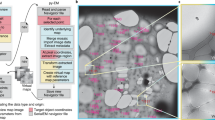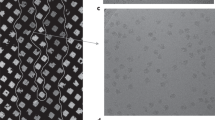Abstract
Transmission electron microscopy (TEM) of rapidly frozen biological specimens, or cryo-EM, would benefit from the development of a phase plate for in-focus phase contrast imaging. Several types of phase plates have been investigated, but rapid electrostatic charging of all such devices has hindered these efforts. Here, we demonstrate electron phase manipulation with a high-intensity continuous-wave laser beam, and use it as a phase plate for TEM. We demonstrate the laser phase plate by imaging an amorphous carbon film. The laser phase plate provides a stable and tunable phase shift without electrostatic charging or unwanted electron scattering. These results suggest the possibility for dose-efficient imaging of unstained biological macromolecules and cells.
This is a preview of subscription content, access via your institution
Access options
Access Nature and 54 other Nature Portfolio journals
Get Nature+, our best-value online-access subscription
$29.99 / 30 days
cancel any time
Subscribe to this journal
Receive 12 print issues and online access
$259.00 per year
only $21.58 per issue
Buy this article
- Purchase on Springer Link
- Instant access to full article PDF
Prices may be subject to local taxes which are calculated during checkout




Similar content being viewed by others
Data and materials availability
The raw TEM images collected over the course of this study are available from the corresponding author upon request.
Code availability
The code for fitting the light wave micrographs is available from the corresponding author upon request.
References
Cheng, Y., Glaeser, R. M. & Nogales, E. How Cryo-EM became so hot. Cell 171, 1229–1231 (2017).
Mahamid, J. et al. Visualizing the molecular sociology at the HeLa cell nuclear periphery. Science 351, 969–972 (2016).
Glaeser, R. M. Invited Review article: methods for imaging weak-phase objects in electron microscopy. Rev. Sci. Instrum. 84, 111101 (2013).
Zernike, F. Phase contrast, a new method for the microscopic observation of transparent objects. Physica 9, 686–698 (1942).
Henderson, R. The potential and limitations of neutrons, electrons and X-rays for atomic resolution microscopy of unstained biological molecules. Q. Rev. Biophys. 28, 171–193 (1995).
Boersch, H. Über die Kontraste von Atomen im Elektronenmikroskop. Z. für. Naturforsch. A 2, 615–633 (1947).
Danev, R., Buijsse, B., Khoshouei, M., Plitzko, J. M. & Baumeister, W. Volta potential phase plate for in-focus phase contrast transmission electron microscopy. Proc. Natl Acad. Sci. USA 111, 15635–15640 (2014).
Danev, R., Tegunov, D. & Baumeister, W. Using the Volta phase plate with defocus for cryo-EM single particle analysis. eLife 6, e23006 (2017).
Jones, E., Becker, M., Luiten, J. & Batelaan, H. Laser control of electron matter waves. Laser Photonics Rev. 10, 214–229 (2016).
Müller, H. et al. Design of an electron microscope phase plate using a focused continuous-wave laser. New J. Phys. 12, 073011 (2010).
Schwartz, O. et al. Near-concentric Fabry-Pérot cavity for continuous-wave laser control of electron waves. Opt. Express 25, 14453–14462 (2017).
McMorran, B. J. et al. Electron vortex beams with high quanta of orbital angular momentum. Science 331, 192–195 (2011).
Freimund, D. L., Aflatooni, K. & Batelaan, H. Observation of the Kapitza–Dirac effect. Nature 413, 142–143 (2001).
Kozák, M., Schönenberger, N. & Hommelhoff, P. Ponderomotive generation and detection of attosecond free-electron pulse trains. Phys. Rev. Lett. 120, 103203 (2018).
Kapitza, P. L. & Dirac, P. A. M. The reflection of electrons from standing light waves. Math. Proc. Camb. Phil. Soc. 29, 297–300 (1933).
Spence, J. C. H. High-Resolution Electron Microscopy 4th edn (Oxford Univ. Press, 2013).
Ryabov, A. & Baum, P. Electron microscopy of electromagnetic waveforms. Science 353, 374–377 (2016).
Barwick, B., Flannigan, D. J. & Zewail, A. H. Photon-induced near-field electron microscopy. Nature 462, 902–906 (2009).
Morimoto, Y. & Baum, P. Diffraction and microscopy with attosecond electron pulse trains. Nat. Phys. 14, 252–256 (2018).
Vanacore, G. M. et al. Attosecond coherent control of free-electron wave functions using semi-infinite light fields. Nat. Commun. 9, 2694 (2018).
Feist, A. et al. Quantum coherent optical phase modulation in an ultrafast transmission electron microscope. Nature 521, 200–203 (2015).
Frank, J. Advances in the field of single-particle cryo-electron microscopy over the last decade. Nat. Protoc. 12, 209–212 (2017).
Danev, R. & Baumeister, W. Expanding the boundaries of cryo-EM with phase plates. Curr. Opin. Struct. Biol. 46, 87–94 (2017).
Merk, A. et al. Breaking Cryo-EM resolution barriers to facilitate drug fiscovery. Cell 165, 1698–1707 (2016).
Li, Y. et al. Atomic structure of sensitive battery materials and interfaces revealed by cryo–electron microscopy. Science 358, 506–510 (2017).
Pinard, L. et al. Mirrors used in the LIGO interferometers for first detection of gravitational waves. Appl. Opt. 56, C11–C15 (2017).
Freimund, D. L. & Batelaan, H. Bragg scattering of free electrons using the Kapitza-Dirac effect. Phys. Rev. Lett. 89, 283602 (2002).
Yasin, F. S. et al. Probing light atoms at subnanometer resolution: realization of scanning transmission electron microscope holography. Nano Lett. 18, 7118–7123 (2018).
Kruit, P. et al. Designs for a quantum electron microscope. Ultramicroscopy 164, 31–45 (2016).
Juffmann, T. et al. Multi-pass transmission electron microscopy. Sci. Rep. 7, 1699 (2017).
Black, E. D. An introduction to Pound–Drever–Hall laser frequency stabilization. Am. J. Phys. 69, 79–87 (2000).
Martin, M. J. Quantum Metrology and Many-Body Physics: Pushing the Frontier of the Optical Lattice Clock PhD thesis, Univ. Colorado Boulder (2013).
Acknowledgements
We thank R. Adhikari, B. Buijsse, W. T. Carlisle, A. Chintangal, E. Copenhaver, P. Dona, S. Goobie, P. Grob, B. G. Han, P. Haslinger, M. Jaffe, F. Littlefield, G. W. Long, E. Nogales, Z. Pagel, R. H. Parker, X. Wu, V. Xu and J. Ye for helpful discussions and assistance in various aspects of the experiment. This work was supported by the US National Institutes of Health grant 5 R01 GM126011-02, the US National Science Foundation Grant no. 1040543, the David and Lucile Packard Foundation grant 2009-34712, and Bakar Fellows Program. O.S. is supported by the Human Frontier Science Program postdoctoral fellowship LT000844/2016-C. J.J.A. is supported by the US National Science Foundation Graduate Research Fellowship Program Grant no. D.G.E. 1752814. S.L.C. is supported by the Howard Hughes Medical Institute Hanna H. Gray Fellows Program Grant no. GT11085.
Author information
Authors and Affiliations
Contributions
R.M.G. and H.M. conceived and supervised the project. O.S., J.J.A., S.L.C. and C.T. performed the experiments and processed the data. All authors contributed to the preparation of the manuscript.
Corresponding author
Ethics declarations
Competing interests
O.S., J.J.A., R.M.G. and H.M. are inventors on US patent application no. 15/939,028. All other authors have no competing interests.
Additional information
Peer review information Allison Doerr was the primary editor on this article and managed its editorial process and peer review in collaboration with the rest of the editorial team
Publisher’s note Springer Nature remains neutral with regard to jurisdictional claims in published maps and institutional affiliations.
Supplementary Information
Supplementary Information
Supplementary Notes 1–9
Rights and permissions
About this article
Cite this article
Schwartz, O., Axelrod, J.J., Campbell, S.L. et al. Laser phase plate for transmission electron microscopy. Nat Methods 16, 1016–1020 (2019). https://doi.org/10.1038/s41592-019-0552-2
Received:
Accepted:
Published:
Issue Date:
DOI: https://doi.org/10.1038/s41592-019-0552-2
This article is cited by
-
Bridging structural and cell biology with cryo-electron microscopy
Nature (2024)
-
Nonlinear-optical quantum control of free-electron matter waves
Nature Physics (2023)
-
Tunable photon-induced spatial modulation of free electrons
Nature Materials (2023)
-
Cryo-electron tomography on focused ion beam lamellae transforms structural cell biology
Nature Methods (2023)
-
Determining the structure of the bacterial voltage-gated sodium channel NaChBac embedded in liposomes by cryo electron tomography and subtomogram averaging
Scientific Reports (2023)



